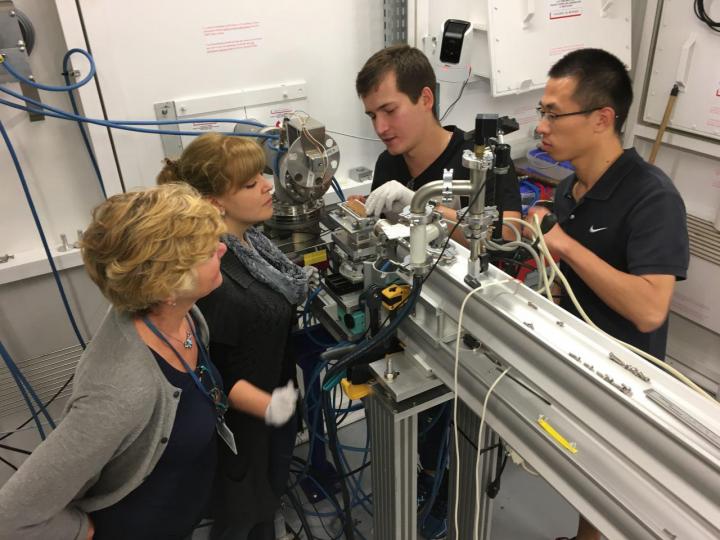A new approach will help save X-ray studies from failing results due to the peculiarities of single-crystal X-ray optics
X-rays are widely used to study the structures of various objects. New sources of x-rays, like Free Electron Lasers and 4th generation synchrotrons are being built around the Globe. The best optics for the new sources is usually made of the single crystal materials, such as silicon, germanium or diamond. However, the ideal periodicity of crystals leads to some unwanted diffraction losses – X-ray glitches. This effect causes dips in the intensity of the radiation transmitted through the optical element, down to zero. Scientists from the Immanuel Kant Baltic Federal University with foreign colleagues have developed a method that allows not only to predict the appearance of glitches but even to eliminate their influence on experiments.
The structure of a substance determines its properties. Therefore, there is no need to dispute the importance of materials science. The most effective, non-destructive, and actively developing nowadays are X-ray methods based on the interaction of the corresponding radiation with a substance. Its new sources (generations 4+) generate X-ray beams with immensely high brightness and a degree of spatial coherence. For taking full advantage of such beams, new optics capable of fully forming, focusing, and transporting radiation without significant distortions and losses, are required. Not any material is suitable – the features of its atomic structure and the presence of any surface and volume inhomogeneities can significantly affect the outcome.
Single-crystal diamond has long been assumed as an ideal candidate for the material for manufacturing X-ray optics: it is mechanically and thermally stable, poorly absorbs radiation, has a small number of impurities, and a suitable crystal structure. This means it is an X-ray amorphous material, which microstructure prevents a beam from scattering. So the radiation is used by scientists without losses, and the optics based on it has increased resolution and sensitivity. However, working with a single crystal diamond possesses one issue – the effect of diffraction loss or X-ray glitches. So are the “dips” in the intensity of radiation passed through the optical element are called. It happens when the X-ray beam passes through the optical element, for some wavelengths the condition (called the Wolfe-Bragg condition) fulfills then a part of the transmitted radiation is diffracted in an undesirable direction. This condition could be met rather often, especially for “hard” radiation (with a small wavelength).
Glitches can be inconvenient to researchers in experiments in which a wavelength of the incident radiation changes during measurements. Thus, the jumping intensity for different wavelengths might occur. Even worse, at a constant wavelength, one can accidentally hit the glitch and carry out the entire experiment either at a lower or “floating” intensity. Respectively, this effect has to be taken into account in any research.
“The glitch effect has been known in spectroscopy for a long time and brings some discomfort to researchers. In some cases, they try to ignore it. Otherwise, it is easier to discard the damaged part of the obtained data. However, glitches can appear in any experiment: if with small changes in the radiation intensity, it is possible to compensate for the negative effects by normalizing the transmitted intensity to the incident one, with a strong drop in the intensity, the signal under study can simply “drown” in the noise”, says Nataliya Klimova, Research Associate at the IKBFU International Science and Research Center “Coherent X-ray Optics for Megascience facilities”.
Scientists from the IKBFU and their colleagues from the Center for Free-Electron Laser Science (CFEL) and from the European Synchrotron Radiation Facility (ESRF) have developed a method for accurate simulation and prediction of glitches, as well as getting rid of them. It can be applied to any single-crystal materials. The proposed approach does not require complex calculations, and therefore can be carried out right during the research. Before starting the experiment, it will be necessary to make only one measurement of the spectrum of radiation transmitted through the optical element. Based on the data obtained, using the developed program, it is possible to determine the exact orientation of the lens (or other optical elements) and then calculate where on the spectrum glitches may appear. Moreover, the proposed algorithm allows one to suppress specific glitches in the radiation spectrum. The authors confirmed their theoretical calculations in the course of experiments. The developed program is publicly available and applicable to any X-ray source.
“The results in this article not only continue the study of the previously discovered effect of diffraction losses in single-crystal X-ray optics but offer a reliable way to deal with them under experimental conditions. It will increase the efficiency of refractive single-crystal optics and let tune the work at the beamlines of the 4th generation synchrotron radiation sources”, says Anatoly Snigirev, director of the IKBFU International Science and Research Center “Coherent X-ray Optics for Megascience facilities”.
Scientists continue to work on this topic and are planning additional applications of the discovered effects at modern X-ray sources. Corresponding articles will be published soon.
“This article is just the beginning. Once again, we made sure that correct data processing is not only necessary but also rewarding. A correct physical model allowed us to fully explain the experimental data and also to come up with excellent applications for, at first glance, negative effects. Thus, shortly, we’ll publish even more exciting articles on this topic!” says Oleksandr Yefanov, Seniour Researcher at the German Research Center for Free-Electron Laser Science, DESY, Hamburg.
###
Media Contact
Alexandra Titova
[email protected]
Related Journal Article
http://dx.





